Spotting something fake becomes really quite easy once you know how. Here I’ll walk you through how to spot fake Sea Moss with four simple tips which will help you with identifying where to buy real Sea Moss.
The main things I look for on the surface is the presence of large grains of processed salt, a lack of imperfections that occur naturally, and signs of chemical interference.
I’ve been around the seaweed space for quite some time now, and often visit seaweed farms and engage with people in the industry.
With a trained eye it is easier to spot these things quickly. So I’m going to share with you what I have learned over the years. But before that, we need to look at some popular beliefs around our favourite seaweed and it being fake, or pool grown.
Where did the Fake Sea Moss Story get it’s Momentum?
As you read this, please keep in mind that this article is by no means intended to be derogatory in any sense. This is simply about considering information and doing your own research.
I would rather equip and empower you in sharing how I evaluate things rather than tell you that one Supplier is selling something counterfeit as a ‘true Sea Moss brand’, while another is selling the real deal.
So, going back to 2011, a figure that many of us trust and love took the stage and addressed an audience in the Bahamas which was waiting with bated breath. 1
He spoke of the challenges of fake Sea Moss, and how to spot fake Sea Moss. This was quite some time ago, and I want you to keep in mind that the world of marine biology doesn’t sleep.
For years now I have been immersed in the world of seaweed, and seaweed cultivation. Here, I’ll break down some of the things I know that you need to look for so you know you’re getting real thing.
One of the first points to consider is knowing what real Sea Moss is. To provide a valid example of concern, there is a lot of conjecture and mislabeling of products in the market.
What is sold as Chondrus Crispus on some packages is actually closer to Gracilaria or Kappaphycus Alvarezii. The seaweed that is well known and has it’s metaphorical roots in the Caribbean is not Chondrus Crispus. 2 3 4
Note: the below is a snapshot of a handful of listings that are using the incorrect botanical name. Identifying features on these listing have been blurred out to protect the identity of the Sellers.
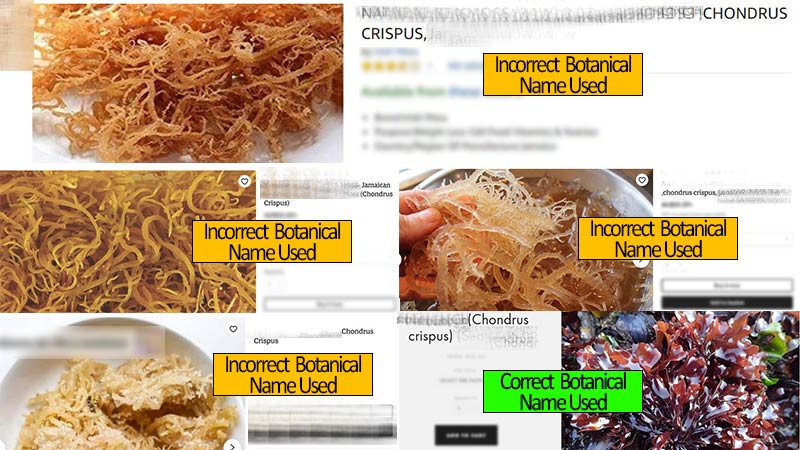
Dr. Sebi spoke about Sea Moss at length, and in the video below, he refers to it in the opening of the presentation as being scientifically known as Chondrus Crispus.
Pay particular attention to what you see at about 4:09 in the video, and make your own judgement call.
In a previous article where we looked at what this amazing seaweed is good for, I wrote about the differences between these seaweeds, which is also worth researching for yourself.
A word of advice though, as great as a resource as Wikipedia is in the eyes of many, anyone without appropriate credentials can create an entry or edit an entry.
I prefer to look to the university studies and marine biology websites as resources for a true reference point.
How Much Sea Moss is Grown in Pools?
There is some truth about the quality of pool grown Sea Moss. When it is grown in pools it is not able to get the benefits of the natural ebb and flow of the Ocean.
Typically this is not grown as a primary crop source. It is more often used in fish farms as a way to help clean the water which is pumped from one pool to the next. This seaweed is not normally sold for human consumption. It is normally used as feed for the fish within the farm, and sometimes it is sold to feed livestock. 5
This means that the exposure to naturally occurring minerals from the Ocean is more or less eliminated. The seaweed is restricted to whatever happens to be added to the tank or pool. These tend to be manufactured fertilizers in some cases, and often a lot of antibiotics.
Something to keep in mind is that this practice is not exclusively applied to what you know as Sea Moss. It is important to be aware of this in knowing how to spot fake Sea Moss, as it is an influential factor.
In some cases, the type of seaweed being grown requires a mineral-dense substrate to be added to the bottom of the pool.
Constraints to Pool Grown Sea Moss for Commercial Purposes
You may have read about seaweed farms replicating the motion of the Ocean with machinery. Sebi spoke of them being able to grow crops of Sea Moss faster in tanks in Boston than in the Ocean.
Growing Sea Moss this way is possible, and in a sense, it is roughly applied in some areas. But when compared to traditional open Ocean seaweed farming it is a comparatively unsustainable and often prohibitively expensive process.
The cost of running a system is typically not profitable when compared to what Mother Nature can do. The practice of pool growing of sea moss that is intended for human consumption is not as widely applied as many of us would be led to believe. Most are for animal consumption.
It is also worth keeping in mind that increasing challenges related to land area, quality, and suitability are seeing this practice lose considerable ground when compared to sustainable open Ocean farming practices.
At the end of the day, the people in the seaweed industry are subject to the same principles of business as the rest of us. Operations at scale are more efficient when conducted in the open Ocean with Mother Nature working her magic.
Low or no profit means the flow of dollars (or pesos, rupiah, dong, or yen, whatever the currency may be) is acutely felt by the business, and the doors soon close when cash flow stops.
Where does Most of the Sea Moss Come From?
The vast majority of Sea Moss commercially available on the market nowadays is grown in the open Ocean. You can see this in some areas if you use Google Earth. Seaweed farms are quite easy to spot.
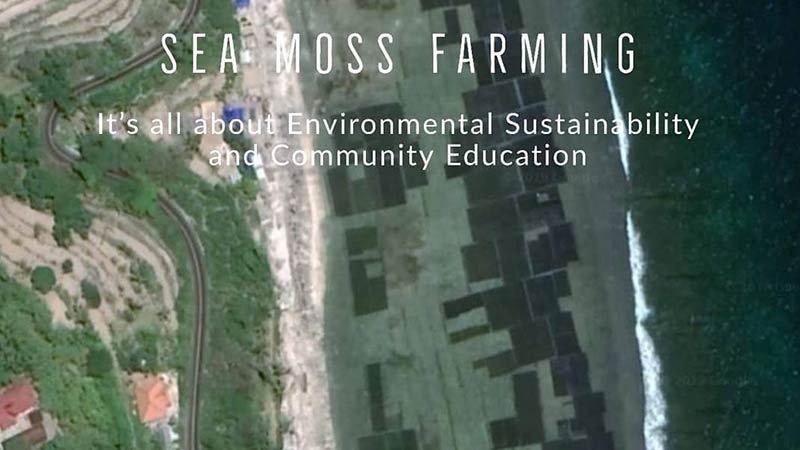
Seaweed farming techniques in the past 20 years have improved dramatically. The application of more advanced engineering has allowed for the development of floating farms that are equipped with features that allow for the reduction in crop loss, while still getting the full benefit of being Ocean harvested. 6
Imagine huge pontoons floating out in deep ocean waters where seaweed can grow on substrates while marine life in the waters benefit from it too. If you ever get the chance to see these first hand, take my word for it, they are a mind blowing innovation!
Technological developments like this have resulted in a natural attrition in the percentage of tank or pool grown seaweed But it is still out there, which is why it’s important to know how to spot fake sea moss.
How do I Identify Fake Sea Moss?
Here are some easy ways to spot fake sea moss that we’ve used over the years. These are based on what we have learned from visiting and working with Seaweed Farmers in many countries.
Tip 1 – The Perfect Look
Does your Sea Moss have that picture perfect look? Meaning, is it all roughly the same size and thickness?
All seaweeds grow in distinct ways. You’ll know pool grown compared to Ocean harvested based on the look.
It’s a bit like being able to tell the difference between home grown or organic vegetables and the commercially grown vegetables you buy at the store.
Real Sea Moss that is grown in the open Ocean will be thicker in some parts than others. It will also have some variations on the length and density of the thallus.
These variations can come about as a result of many different things. Keep in mind that this seaweed is not just a food source for you. It’s primarily, and originally a food source for marine life.
You may see little nobbly bits on your Sea Moss from time to time, particularly at the ends. This is a sign that crustaceans, fish, and possibly even sea turtles have been nibbling the tender young shoots while it has been growing.
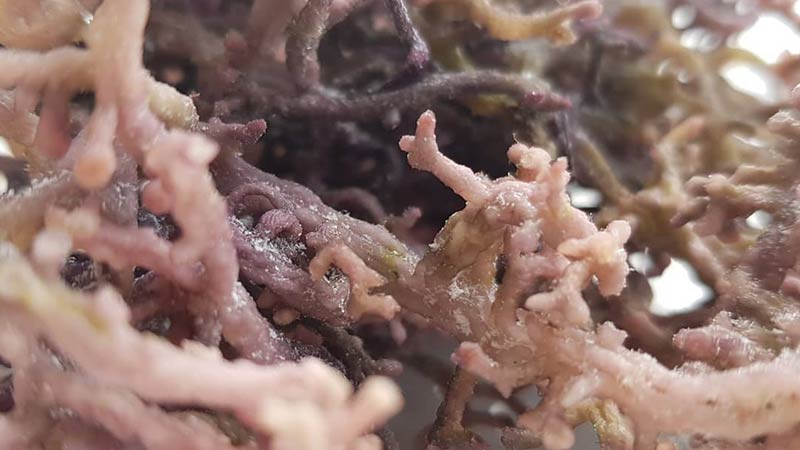
Tip 2 – The Salt Grains
There will be surface salt that naturally occurs, but it’s the size of the salt grains, their formation and appearance, along with the taste that really gives this away.
To say that real Sea Moss has no salt on it is either a indication that it has been grown in fresh water, or washed to the point that all salt water that was trapped inside it has leached out.
Here’s a question for you to ponder; if there is no salt on it (at all), keeping in mind that salt is a crystalline mineral, what other minerals have been eliminated if the resulting ‘salt free’ look of your seaweed? Have they been washed out, or is what you’ve got really from fresh or brackish waters? If it is not from the open ocean, is it then still real?
This might sound a bit like a lightbulb moment for some of you, while others will choose to hold on to their received opinions. As seaweed grows in the open Ocean, it soaks up some of the salt water it grows in. And as a result, when it dries the salt leaches out. This shows up on the surface as salt crystals.
Consider this; is your Sea Moss lightly dusted with salt that is as fine as icing sugar and not all the same shape and colour? Naturally formed salt will often look like there are shards, plates (or flakes), and fine dust.
If it is packaged with grains of salt that look more like rock salt, or table salt, chances are it’s fake.
There’s also a very distinct difference in the taste of natural sea salt and processed table (iodized) salt. Try them and see for yourself.
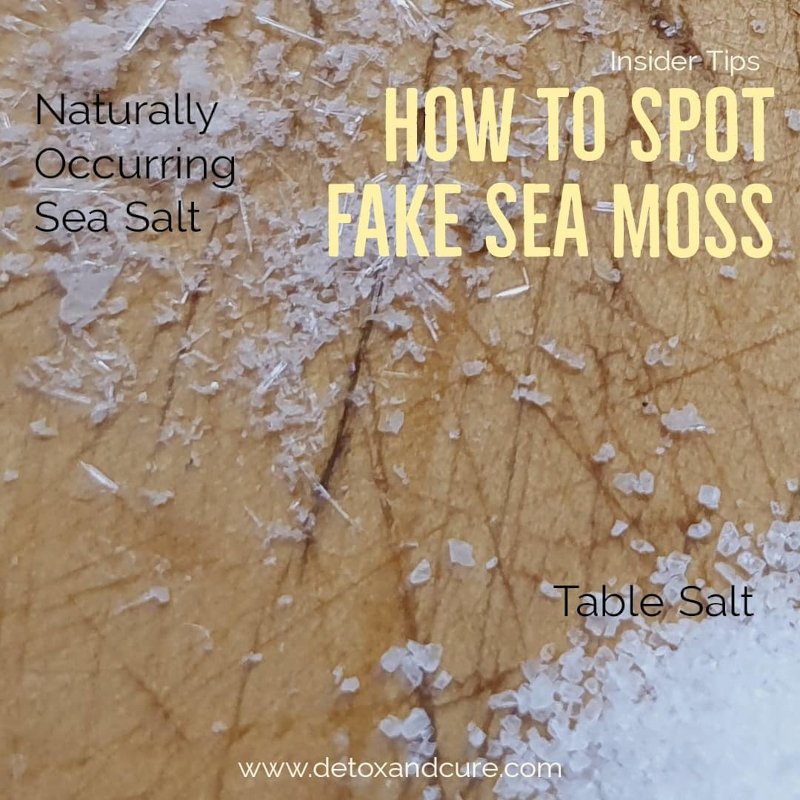
Tip 3 – Other Seaweed with it
Real Sea Moss that is grown in the open Ocean will occasionally have a stray piece of another type of seaweed with it. Our Quality Control Team work very hard to make sure that this is kept to the lowest possible level. Often we get the vast majority of these, but occasionally very small pieces are missed.
After harvesting, any other seaweed that has been caught up in the Sea Moss crop are picked out. Sometimes a few little whispy bits can still be found, but this is rare.
In pools and tanks there are often no other species of seaweed, just the targeted type the Farmer is seeking to grow. Pools also lack sand and the occasional, what we call ‘sea dirt’, which can also be found on some parts of Sea Moss.
Think of sea dirt as the very light silt that can be kicked up in the Ocean during rough waves, storms or surface activity. This can settle on the seaweed. During the growing stages, the Seaweed Farmers tend to the crops in shallow Ocean waters by washing as much of this off as they can.
A heavy build up of this sea dirt sediment can cause the seaweed to suffer. Think of it this way, it blocks the sun and inhibits photosynthesis, which can be thought of as like a type of suffocation.
This can then lead to other complications and the introduction of disease to the crop.
Example: Ice Ice
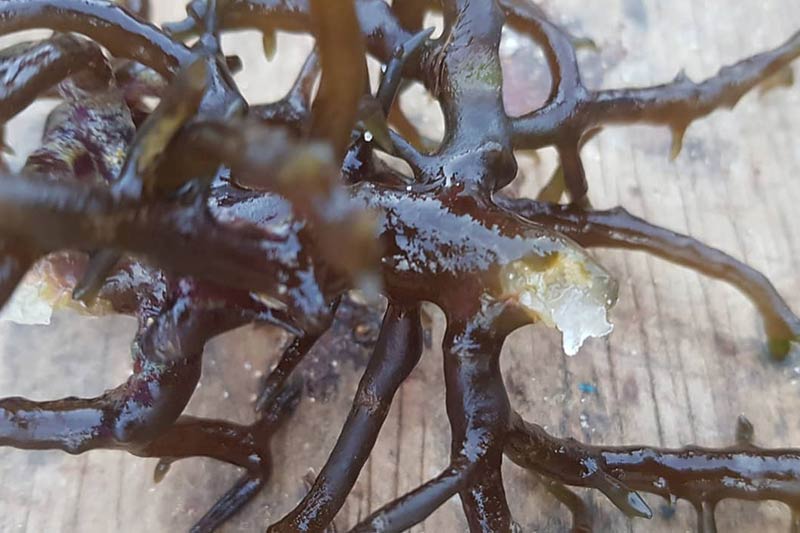
Example: Mold
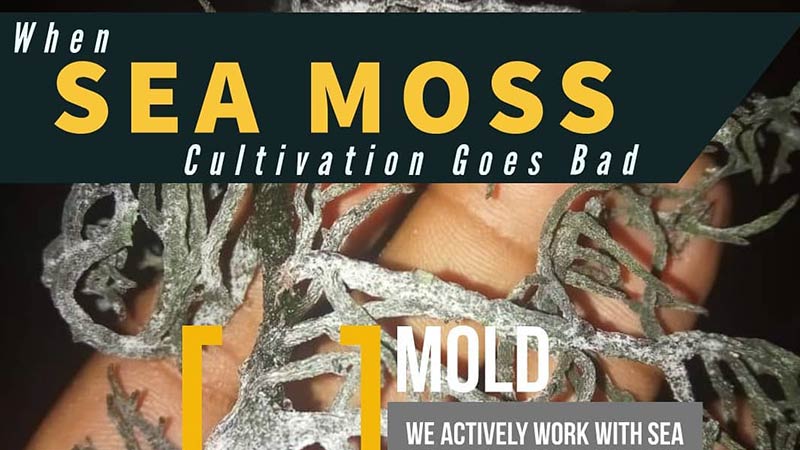
Again, after harvesting, our Team diligently check for seaweed that has too much sand or sea dirt on it. This is set aside and used to give back to the environment. More about that later.
Other than these tips, most Consumers won’t be able really spot fake Sea Moss from the real thing. Not unless they have the seaweed assessed in a laboratory for things like vitamins, minerals and other things.
That’s not even taking into account knowing the species you are working with when considering how to spot fake Sea Moss.
Tip 4 – Differences in Colour or Tone
Authentic open Ocean grown Sea Moss is likely to have some colour variations, or slight differences in tones. Knowing how to spot fake Sea Moss is really easy with this tip.
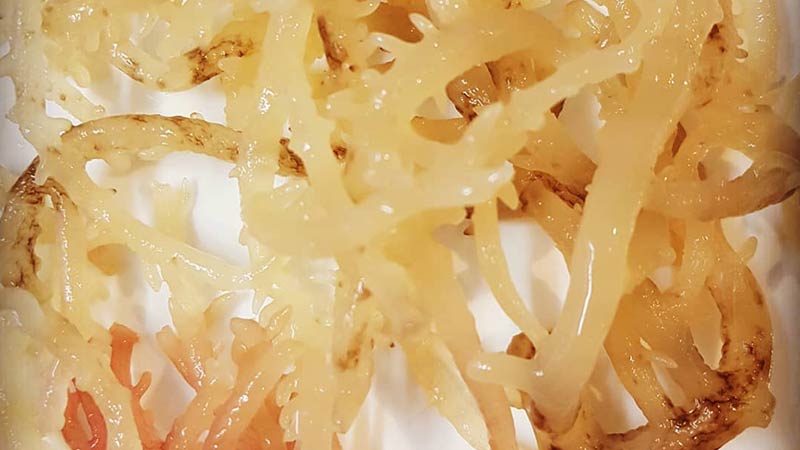
If you’ve got a batch that is all the same colour, it may be fake, or worse still, bleached. Sea Moss naturally comes in a few different colours.
This is a result of where it is grown, and some slight species variations in the seaweed family. This means that for it to be golden white it has required some processing.
This processing is typically a simple application of exposure to sunlight. Depending on the colour of the seaweed, it can often have some tonal variations even after the sun drying stage.
How is the Sea Moss Colour Changed?
It’s a simple process to take Sea Moss from being olive green, purple, brown, red, yellow or a warm orange to the golden white colour you’re more familiar with.
This requires no chemicals when done properly, just controlled exposure to the direct sunlight to sweat out the colour.
Where bleaching has been applied there’s a consistent white look to the Sea Moss. No little darker patches or spots, no pieces that are more fawn than golden white. It looks very processed.
These colour variations after sun drying come from the Sea Moss growing in natural conditions where it is exposed to slight variations in light, temperature and water movements. The retention of these tones are a result of natural sun bleaching, and not the use of chemicals to strip the colour out.
Tank farmed seaweeds will typically not have these variables as they are grown in an extremely controlled conditions. There’s no room for Mother Nature to create such noticeable differences.
How Common is Fake Sea Moss?
As touched upon before, fake Sea Moss isn’t as common as you might be led to believe. Globally, the rise of seaweed farming in the Ocean is on the increase.
Pool grown Sea Moss, in the laboratory, like conditions that Sebi cautioned us about is simply not able to compete with the awesome power and efficiency of Mother Nature and the Ocean.
What is more common is the lower grade quality of seaweed that is intended for animal consumption or industrial application being sold as food grade for human consumption by unscrupulous Sellers out to make a quick buck.
This is the present threat that if faced today in by companies sourcing high quality Sea Moss.
Another thing to consider is that there are lower grades of Sea Moss is grown in the Ocean, but not the quality of waters that you would be happy to have your Sea Moss grown in.
Often, it is in areas that are close to commercial ports and harbors, or waters that are polluted by various types of run off including domestic waste water, agricultural, commercial, and industrial, or in the line of currents from Ocean dead zones. 7
Knowing more about the conditions of the waters, and the currents is vital so that you know you are getting a clean, and mineral dense supply of Sea Moss. 8
There is almost heated debate about the merits of various types of Sea Moss, with a strong cohort beating the drum for wildcrafted Sea Moss; but at what cost?
Where does the Confusion Come From?
With people moving around the planet for generations there have been multiple cases of terminologies being transported with them. Languages have constantly been in a state of flux, and we tend to have slightly different names for the same thing from one culture or language to the next.
For example, cilantro is the same thing as coriander, garbanzo beans are the same thing as chick peas, and amaranth is the same thing as callaloo.
As mentioned in the opening, the name Sea Moss has been applied to different types of seaweed. Through marketing and advertising we have lost a dimension of the truth in this matter. What is known as Sea Moss is actually a completely different thing to Chondrus Crispus.
With Sea Moss being a generic term, what Dr. Sebi was talking about as a species was not Chondrus Crispus. Did you take a look at the video above?
What were your conclusions when you compared this to what you see in the phycology journals?
Why is most Sea Moss Golden or White?
Due to a range of factors (too many to go into here), Seaweed Farmers and companies involved in the harvesting and processing of Sea Moss opted to treat their crops before putting them on the market.
The golden or whiteish colour of the commercially available seaweed is what people have come to know and expect.
As touched upon earlier, this is able to be achieved in most cases during the drying process without the need for any bleaches or other harmful chemicals. It’s typically a simple process of sweating the colour out with the aid of the sun.
This can be done through a number of methods, but typically the use of plastic sheeting is applied. The seaweed is left to sit in the full heat of the sun while covered by clear plastic, and what takes place is it changes from the original colour to a translucent white.
Sun Bleaching Sea Moss
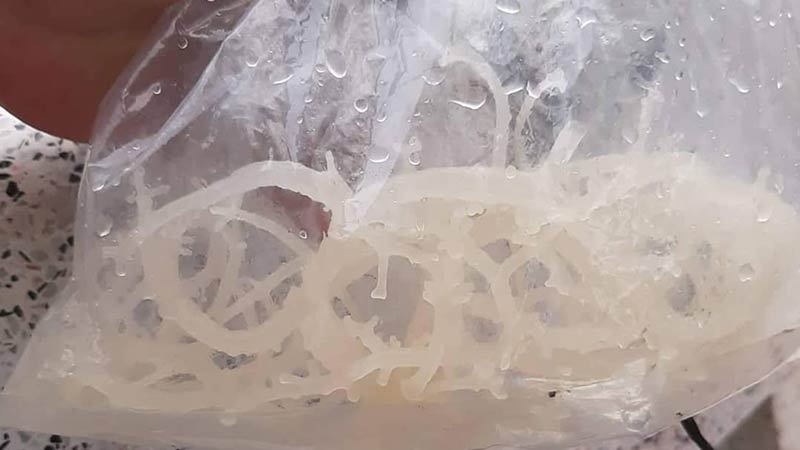
Take a look at this on our Instagram before it was exposed to the sun and the colour had dropped out.
Once the cover is removed, it then dries further, which locks in any tonal or colour variations.
A solid colour that runs through your Sea Moss isn’t a bad thing. It may have been a consistently sun-bleached plant. If it is very white, like cotton wool or paper, then it’s probably been chemically bleached.
Even though this isn’t necessarily key to knowing how to spot fake Sea Moss, it will help you.
Something else to keep in mind, if you buy Sea Moss Gel, it is much easier for someone to sell you fake Sea Moss Gel because it has much less distinguishable characteristics compared to whole leaf Sea Moss.
References
- “Bahamians flock to see herbalist ‘Dr Sebi'” – J. Gibson, 26 September 2011 [Bahamas Local] [Archive] ↩︎
- “Carrageen (Chondrus crispus)” – W. Rayment, P. Pizzola, 22 May 2008 [MarLIN] [Archive] ↩︎
- “Biology of Gracilaria” – Regional Seafarming Development and Demonstration Project, Zhanjiang Fisheries College, August 1990 [FOA] [Archive] ↩︎
- “Kappaphycus alvarezii (Doty) Doty ex P.C.Silva, 1996” – M. D. Guiry, 26 June 2016 [WoRMS] [Archive] ↩︎
- “Seaweed Potential in the Animal Feed: A Review” – T. Morais, A. Inácio, T. Coutinho, M. Ministro, J. Cotas, L. Pereira, K. Bahcevandziev, 30 June 2020 [MDPI] [Archive] ↩︎
- “The Application of Integrated Multi Trophic Aquaculture (IMTA) Using Stratified Double Net Rounded Cage (SDFNC) for Aquaculture Sustainability” – S. P. Putroa, Widowatib, Suhartanac, F. Muhammad, October 2015 [International Journal of Science and Engineering] [Archive] ↩︎
- “What is a dead zone?” – National Ocean Service, 8 March 2021 [NOAA] [Archive] ↩︎
- “Ocean Currents” – National Geographic Society, 20 May 2022 [National Geographic Society] [Archive] ↩︎
Last Updated on 4 months by D&C Editorial Team
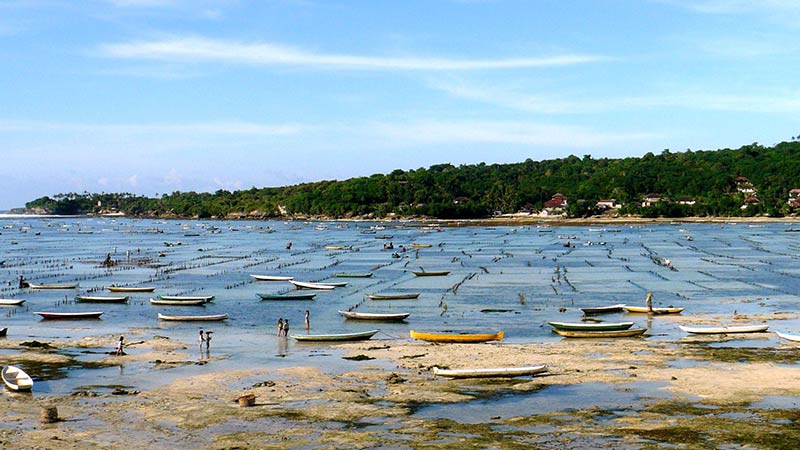
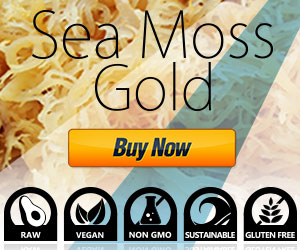

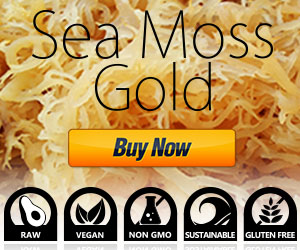



By far the most comprehensive and honest article and overall site on consuming, identifying, preparing, using and selecting sea moss correctly. Love it all! Thank you!
Thank you for your kind feedback Sovery!
Your comment really made us all smile here, and we feel like we’re doing something good for our audience when we have the pleasure of reading messages like this.
Thank you!
Detox & Cure you are a God send!! I was going crazy with everyone selling “fake” sea moss in the internet and how to identify the difference with the real. Thanks a million for this wealth of information. You are doing a great service to the people in internet (like myself) who need guidance with sea mossing. May God repay and bless you all!
Awwww, thank you so much Toni for your lovely message.
We’re happy to be able to share value that others can apply. If you have any questions or topics that you think would be helpful to you, or others to know about in the sea moss space, we would be glad to consider them to see if we can step up.
Fake sea moss is an issue. Hearing about people getting ‘plastic sea moss’ instead of real sea moss is really troubling.
Happy ‘seamossing’ (that’s such a cool word – I’m going to use that more now because of you) Toni! Stay amazing!
Hi
Can you recommend any links to buy real sea moss?
X
Hello Del,
I can speak highly about our Sea Moss as we have full visibility of the process and know the quality intimately. You can find this in our Store at https://detoxandcure.com/product/sea-moss-gold/
Currently we have a promo running where the code is SUSTAINABLE2020. Maybe that will unlock something exciting for you.
I recently purchased sea moss but it was purple . Is there a purple species of sea moss
Hello Shawn,
Thank you for your question. Depending upon the species of seaweed that is being sold as Sea Moss, it may be purple. Typically, Sea Moss is going to be dark olive green, yellow, red, or even purple. It goes through a process of sun drying which strips the color out of it.
So, your purple Sea Moss should be ok. Given that we don’t currently sell purple Sea Moss, and you didn’t buy through us, I can’t speak to the authenticity of the product itself. If the tips on how to spot fake sea moss from this article are causing other red flags to pop up for you, then you may have valid grounds for concern.
Would you say the ****** (name removed by Admin to protect the identity of the company) Irish sea moss is real? I got it at a Caribbean store
Thank you for your question, Cassandre.
Our Admin has advised that it is best to not state the name of the company you are asking about so there is no potential negative impact on their business.
As they don’t have that much detail that I could find on their product, I can’t say if it is or isn’t fake. Spotting fake sea moss is more effective when you have it in your hands, and you can evaluate it for yourself.
I would suggest that you contact them (you know who they are), and ask them about their product.
They do carry a few lines that seem to be the same, but are packaged very differently. This causes me to quirk a brow as to where they are getting their sea moss from. They don’t have much information on their site, and the images are quite blurry, so I can’t really say.
One point that I would suggest you consider is the truth behind their label saying the product is ‘wildcrafted’. We have some articles about our values with regards to wildcrafting here. We’re not fans of it as a methodology for certain reasons.
Most sea moss that is sold as wildcrafted actually isn’t, so, you’ve got to wonder about what else they aren’t being truthful about. I get that it’s a hot buzz word, and an attractive branding angle, but does wildcrafting sea moss actually help our Planet? I’ll leave that for you to consider in line with your values system.
I hope that this has been helpful.
This is an awesome article! Thanks for sharing!
Thank you so much for your kind feedback, Altanya.
It’s a good feeling to know that we’ve been able to bring value to the community.
Can you tell me where to purchase authentic wholesale seamoss? I know so many ppl who want it, I would like to sell it.
Hello Arlethia,
We are able to offer wholesale prices for you if you are looking to buy Sea Moss online through us.
Good Morning! Thanks so much! Recently there has been an influx in the use of moss & making of gel. Many are goin after the moss from st Lucia bringing to light that it doesn’t have any salt or sand. From my research, it appears that they may be using pool farms not brine but lines in the ocean vs moss off the rocks. Finger like tips is also something i noticed it lacked. Gracilaria seems to be the kind that was referenced by Dr Sebi. I went the length to reach out to Jamal for clarity yesterday.
Thanks in advance!
Thank you for sharing this with us Kee.
It’s been a while sine I was last in the Caribbean. As you can appreciate, things change from one season to the next in the business world, more so in smaller businesses from my experience.
The last Seaweed Farmer I met in that part of the world was using lines to grow his Sea Moss, but this was in the open ocean (about waist deep water at high tide), not in pools.
Hello. I have a question please. When soaking my sea moss, after a couple of days, I notice the tips on some it turn a brown color? What is this? Is it normal?
Hi Deanna,
I suspect that the Sea Moss was not completely submerged when you were soaking it. In this instance, yes this would be normal because the sections of the Seaweed that are exposed to the air are drying out while the rest of the submerged Seaweed is under water.
Coming Soon: We are currently crafting an article to explain more about how to prepare Sea Moss for use. We will include more information about how to avoid the tips of your Sea Moss from turning brown.
Well this is a great article very informative. Thanks!
Thank you for your feedback Jeremy. I’m glad that you found this information helpful. 🙂
I just got wild crafted sea moss from Kingston, Jamaica. It says wild crafted but when I got it, it was dusted full of powdery salt. When I soaked it for an hour in room temperature water, the water turned to jelly. The sea moss expanded so much. I washed all the slimy water off. Soaked it overnight and this morning, the whole bowl of water turned to thick jelly. It reminds me of my kids toys where you put in water and they expanded and all the water turned to jelly. I don’t think what I got was real at all? I don’t think it’s even farmed sea moss? Help?
Hello Vikki,
That does sound strange. Do you happen to have any left over that you haven’t soaked? If so, I would be happy to take a look at a few photos if you can get close up shots. It would be worth sharing some images of what you have experienced with how it went to jelly the way it did.
I’m hoping that you haven’t been sold an inferior product. Spotting fake sea moss is much easier to do when you have it in your hands, but I’ll see what I can do to help you if you’ve got some photos you can share. The best way would be to tag us on Instagram with these.
Hi there! I was wondering if you could check this sea moss please and let me know whether you think it’s the farmed type as opposed to wild crafted…it was bought online but I have no clue. There wasn’t too much salt on it but instead spots of white which I’ve tried to capture in the pictures.
There also seemed to be a mix in its colour so not really just gold but different shades of brown/purple/gold.
Would really appreciate your opinion!
(P.s how can I send/uploaded photos?)
Thanks 😊
Hello Sabrina,
Apologies for the delay in replying to your comment. I have sent you an email asking if you can send me the photos and I’ll take a look for you.
Alternatively, if you have an account with any of the below platforms you’re welcome to tag us / send us the image there:
Reddit
Facebook
Twitter
Instagram
Pinterest
I’ll take a look at what you’ve got and see if anything stands out. The good thing about the social option is that it could also help others with similar challenges too.
Hi
Iv recently bought some seamoss, and not sure whether this is the real deal or not. I am used to seeing it this way, until I saw a yellow batch that looked coated in salt. It also tastes different (more like the sea and has a brown color when made into gel) compared to the golden type you usually see. Can you please have a look at it and advise me?
Hello Anita,
I would be happy to take a look at this for you. Could you send us some photos on Instagram (@DetoxAndCure) and I’ll take a look for you?
Hi
I appreciate your guide.
I’d like to send a photo of the seamoss I purchased. It also became super gelatinous within an hr.
Sure thing Carmen,
If you’re on any of these social platforms you can tag us / send us the image:
Reddit
Facebook
Twitter
Instagram
Pinterest
We’ll take a look and see if there’s something we can help you with. It may also help others with a similar challenge too.
Thank you for this guide. It is a great piece. I was wondering, is the (REDACTED) brand Irish Moss real? They sell it for $(REDACTED) for a (REDACTED)oz bag. Thanks four your assistance.
Hello Jerry,
Thank you for your question. I have redacted the name of the company and the price point that you were asking about as it is not our intention to harm anyone’s business or brand. I think there is more to consider than just the authenticity of the product here. It may well be the real deal, but then again, it may not be either.
Given the price point you mentioned, which is very cheap, I would be questioning a few things like how low are they driving the price from their Supplier to be able to sell to you at this price point. If they are metaphorically screwing their Supplier down so low that the Supplier is only just making a little money, then that’s not fair on the people doing the original hard work.
We firmly believe that everyone has to win in order for a business to be sustainable and to support it’s underlying mission. It’s not all about making fat stacks for all of us in the retail market, quite the opposite for many of us.
That’s a lengthy conversation, and one that I recently had with a Sea Moss Seller based out of Canada who I encouraged to think about how he could use what he was doing to drive more value back to the Supplier (Farmer) so they could improve their situation. As you might be able to tell, once you get me going on fair dealings in business, I’ve got a soap box, that’s for sure.
Another thing to consider when you’re looking at such a low price point is the cost of various essential business functions like quality control, Worker safety and wellbeing, product testing and evaluation to make sure it is safe to consume, logistics, packaging, compliance requirements, taxes and a whole lot more. Sometimes cheap doesn’t equal nasty, but sometimes it does.
I’m not saying that is the case here as I don’t know first hand. What I am sharing with you here is that there are costs in getting a product like this to a Customer, like you, and ensuring that the spectrum of obligations and fair market dealings are met. If you’re really interested in finding out more about their values and ethics, ask them. Seek out proof that backs up your perceptions and aligns with your values. I can’t help but wonder what’s behind that curtain.
One thing I would like to be clear on is that I would ask that you don’t come at them like they have done something wrong; it’s entirely possible that they haven’t. But, your questions about their product should be directed to them. I hope this helps.
I enjoyed the article
Where can I purchase REAL
Sea moss?
Not farm made
Hi Gloria,
Thank you for your feedback.
You could collect your own Sea Moss for personal use. Wildcrafted Sea Moss is a romantic ideal, but realistically it is not commercially viable. Unfortunately, it is difficult to buy Sea Moss that has not been farmed. But as far as providing Sea Moss to the world in commercial quantities, this would need to be farmed. So, I guess another question might be, where can I buy sustainably farmed Sea Moss from?
Our Sea Moss is sustainably farmed in the open ocean. You can Buy Sea Moss online from us. We strive to make content which helps people make better informed decisions about buying Sea Moss.
I submitted a comment to you months ago for this article and you’ve completely ignored me answering other people’s comments who’ve submitted their queries after I did – do you know how upsetting this is to see?
Hello Sabrina,
Apologies for the delay in getting back to you. The original comment you made was flagged as spam, but I’ve addressed that now. I’ve also sent you an email a couple of days ago in response to your comment above where I’ll be happy to take a look at what you’ve got if you could email me a few photos.
I can appreciate that it is disappointing that your message seemed to be overlooked. We do get a lot of messages through different streams, and those that are blocked by various systems sometimes take longer to get back to. Sometimes we have so many that it takes days for us to get through the responses.
Also, please keep in mind that we are a small Team and the only means of covering the costs of what we do is through the sale of our Sea Moss, we don’t charge for our time and we keep our content freely open without injecting advertisements that take away from your experience here. The only ads we do have are for the products on our website that are congruent with why you are here. You’re looking for info about Sea Moss, we sell Sea Moss so we have those ads up. You won’t find ads on our site that are based on retargeting through pixels.
We get a lot of people asking about Sea Moss they have purchased through other Sellers and we help out where we can. This is done in a tactful manner to not harm the business interests of other Sellers.
Also, please note that like with all of our replies to comments, we amend the date and time of the reply to sit below the original question to help other readers get the flow of the conversation rather than replies seeming disconnected and confusing.
I look forward to your reply and appreciate your understanding.
Hi, and thank you for this informative post! I am a bit confused on one thing. I understand that Chondrus crispus, Gracilaria, and other algaes are referred to as Irish moss by different people. But my question is: are you saying that Dr. Sebi called the seamoss he uses “Chondrus crispus”, but he was actually using a different species (for example Gracilaria)?? Thanks!
Hello Ann Marie,
Thank you for your question. It’s one we get asked quite a lot, which is why we went into the detail we did here. Accuracy of information is important, and with Sea Moss being something that more study is needed on, along with other seaweeds, we’re always learning as we grow.
What I am saying in this article is that you need to question the information and do your own research.
With regard to your question specifically, a good starting point would be to scroll back up to the video (https://youtu.be/zMWnZn9gI8g) in the post, listen to the scientific name used in the video (Chrondus Crispus) at about 38 seconds in, and then skip to about 4 minutes and 9 seconds in and look at the sample of what is held up.
I can’t speak as to why the Honorable Dr. Sebi called what he held up “Chrondus Crispus” in this video. I can however say that it is not Chrondus Crispus.
The thing that saddens me here is that a lot of people are selling online Sea Moss that they call Chrondus Crispus when it is not.
I see this as being a challenge as it disempowers those seeking information on what they are consuming. There are some 35,000 plus species of seaweed on the plant that we know of to date.
Maybe, back when this was filmed, accessibility to information was not as good as it is today with internet being in many parts of the world.
There were, however, in many countries, libraries packed full of resources like encyclopedias in hard copy form and marine journals that clearly documented Chrondus Crispus. The first thing I believe that people need to be informed about when learning about how to spot fake Sea Moss is to know that what Sebi is holding up is not Chrondus Crispus.
Chrondus Crispus does not grow in warmer tropical waters, and it does not look like a golden twig as you see in the video.
The Sea Moss that Dr. Sebi is holding up is what you want to find if you are looking for what he speaks about. It’s just not known scientifically as Chrondus Crispus.
I hope this helps to clarify things for you.
Hi, I recently saw sea moss for sale at my local farmer’s market labeled as Vietnamese Sea Moss. What are your thoughts on that vs sea moss from the Caribbean? Thank you.
Hello Joslynn,
Thank you for your question. This is a multi-dimensional consideration for me as there are many flow on aspects of this that require consideration.
There are a lot of assumptions made about places that are simply not true, so I would suggest that objective investigation and analysis be the basis of forming a conclusion rather than what is called a ‘received opinion’. A received opinion is one that is taken as fact based on who has expressed it. This is largely based on the level of trust placed in that person as an authority.
That being said, I urge you not to take what I say here as fact without conducting your own research as this would be yet another received opinion.
In an effort to clarify my perspective, I have visited many places and spent time in areas where seaweed farming is the primary source of income for seaside villages and many families. I have taken samples from regions across the world and evaluated them all on the same basis. Some of the cleanest waters in the world can be found in the least likely places when you take assumptions out of the picture.
Vietnam has a few places where the water conditions (both from a current perspective and runoff perspective) are very clean. In fact, cleaner than some other places in the Indian Ocean, Caribbean, Atlantic and Pacific. I would caution you that there are some seaweed suppliers operating out of Vietnam who harvest their seaweed in waters that I have visited that are substandard.
I have seen things in Instagram worthy parts of Indonesia that seaweed is grown that have caused me concern as to the safety of their product. I can say the same for places like Mexico, Jamaica, St. Lucia, Mauritius, Malaysia, the Solomon Islands and more.
Our Sea Moss is grown in the cleanest waters we could find, along with a whole host of other considerations. We share our process openly on what we consider before buying Sea Moss.
I would suggest that you request further information on the product you have mentioned from the Seller. However, if they have an agreement in place with a small farmer, like we do, they may not be very forthcoming in disclosing too much as they have business interests to protect.
Please keep in mind that seaweed farming can be a very cut throat market. I have spoken with many small seaweed farmers who have been pressured into selling their stock at unfairly low prices when unscrupulous Buyers enter their market. And seen the other side of the coin where the local price is bid up higher than what the locals can afford to pay for what is a staple in their part of the world. This is very much like what happened when Quinoa became popular.
I hope this helps you.
Why we can’t sue these company’s selling us fake product than we gotta find out at the last minute yall tryna kill us ..like we knew it wasn’t real at first for beginners f**k y’all I’m going to find witchcraft
Hello Adonis,
Thank you for sharing your feelings with us. I’ve made one tiny edit to your comment to add ** in the place of a couple of letters to remove the expletive as we don’t allow profanity on our website, but I do get your feeling here.
We spend so much time working with communities and individuals to help bring people together so they can learn from each other that when we encounter what you describe here we feel frustrated and annoyed too. The best thing to do in my experience is to learn more and operate from a basis of fact and being accurately informed. This is why we do, and share, our research here freely.
There are so many Spruikers in this space who are sharing information that is not correct, not backed up by studies, and if they claim there are studies more often than not they can’t point their audience to these studies, and they certainly have not travelled the world to first hand see and work with people in the seaweed industry.
I’ll close this reply out by saying that operating on what is called a received opinion (the opinion of someone else) without testing it’s basis of truth yourself is commonplace today. This is why the term “Influencer” is used on social media – the intention is to influence, and quite often little else.
Learn more, operate from clarity and being informed, share your factual understanding with complete transparency and back it up with proven fact, and temper it with the right amount of emotion so you don’t lose your audience.
I hope this helps you.